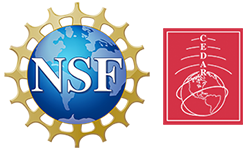2025 Workshop: Predictability of the geospace environment
Hanli Liu
Mike Wiltberger
Aaron Ridley
Tom Berger
Ben Martinez
Research into the predictability of the geospace environment (mesosphere, ionosphere, thermosphere, and magnetosphere) is critical for advancing space weather forecasting capabilities. Advances in modeling, data assimilation, and observations are also critical to improve space weather predictions. Despite its importance, research into the predictability of the geospace environment remains limited, leaving a number of outstanding questions. For example, the limit of deterministic predictability in the troposphere has long been understood to be ~2 weeks, though we currently have little understanding of the predictability limits in the geospace environment. How the predictability limits vary across spatial scales and in different components of the geospace environment are also largely unknown. Knowledge of the sources of predictability during quiet and disturbed time periods is also limited. This session solicits presentations focused on fundamental research into predictability of the geospace environment, as well as advances in modeling and observations that will lead to advances in predictions of the geospace environment from short (days to weeks) to long (months to years) time scales.
10:00 - 10:13 Valery Yudin, Evaluation of the first FV3WAM forecasts by current ITM observations
10:13 - 10:26 Min-Yang Chou, Assessment of Ionospheric Model Performance over the U.S. during the Gannon Storm using Single-Frequency GNSS Precise Point Positioning
10:26 - 10:39 Jack Wang, Neutral Density in the Storm-Time Thermosphere: Model Assessment and Web-Based Tools
10:39 - 10:52 Mike Liemohn, Prediction Efficiency Skill Scores for Event Detection
10:52 - 11:05 Jiahui Hu, CAM-NET: An AI foundation model for whole atmosphere forecasting trained on WACCM-X data
11:05 - 11:18 Ben Martinez, IT Predictability During SSWs with CESM2(WACCM6) and TIE-GCM
11:18 - 11:31 Christine Gabrielse, Radiation Belt Daily Average Electron Flux Model (RB-Daily-E) From the Seven-Year Van Allen Probes Mission and Its Application to Interpret GPS On-Orbit Solar Array Degradation
11:31 - 11:44 Sevag Derghazarian, The Link between Daytime MSTIDs in North America and Stratospheric GWs from Multiple Longitudes over Nine Winters
11:44 - 11:50 Yaga Richter, The NSF NCAR ESPAT Initiative: Opportunities for Collaboration
Virtual Information:
CEDAR / GEM Geospace Predictability
Google Meet joining info
Video call link: https://meet.google.com/bse-fuop-std
Or dial: (JP) +81 3-4545-0450 PIN: 526 031 943 6405#
More phone numbers: https://tel.meet/bse-fuop-std?pin=5260319436405
Advancing space weather forecasts is critical due to the increasing dependence of society on space based technologies. A key component of developing improved forecasting capabilities is fundamental research into the predictability of the geospace environment. Knowledge of the predictability of the geospace environment is currently limited as it has not historically attracted significant attention within the scientific community. However, the CEDAR/GEM communities are well poised to conduct the fundamental research into the predictability of the geospace environment, which will ultimately help to improve space weather predictions. The CEDAR/GEM communities also have a key role to play in the development of models, observations, and data assimilation techniques that can lead to enhanced space weather predictions. This session aims to promote predictability research within the CEDAR/GEM communities through presentations that (1) highlight recent research on the predictability of the geospace environment, (2) discuss advances in modeling and observations that will enhance predictability research, and (3) exposing students and early career scientists to predictability research.
